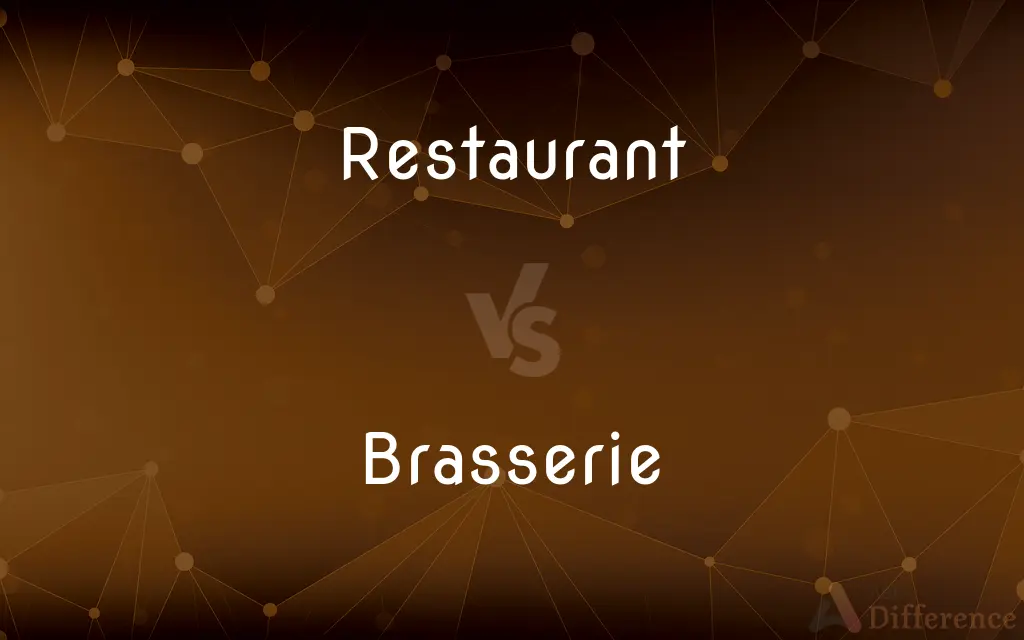Restaurant vs. Brasserie — What's the Difference?
By Tayyaba Rehman & Fiza Rafique — Updated on March 18, 2024
A restaurant is a broad term for establishments serving meals and drinks, while a brasserie is a type of informal restaurant originating in France, known for serving a wide range of drinks and simple, hearty meals.

Difference Between Restaurant and Brasserie
Table of Contents
ADVERTISEMENT
Key Differences
Restaurants encompass a wide variety of dining establishments, from casual to fine dining, each offering different cuisines, service styles, and atmospheres. Brasseries, on the other hand, are characterized by their relaxed, often lively atmosphere, and traditionally offer a large selection of beers and a straightforward menu, often featuring classic French dishes.
While restaurants can vary greatly in their offerings and level of formality, brasseries are typically more consistent in their approach, aiming to provide a casual dining experience with a focus on good food and drinks in a convivial setting.
In a restaurant, the dining experience can range from quick and informal to luxurious and elaborate, with menus that may change seasonally or feature chef's specialties. Brasseries, however, often have a more static menu with staples like steak frites, salads, and seafood platters, catering to diners looking for reliable, unpretentious fare.
The term "restaurant" can apply to any establishment serving food, whereas "brasserie" specifically refers to the French-inspired casual dining spot, often large and bustling, making it a popular choice for both everyday meals and social gatherings.
Restaurants may require reservations, especially for fine dining experiences, and might have dress codes, while brasseries are usually walk-in friendly, making them accessible for spontaneous dining. The service in restaurants can range from self-service and fast-casual to full-service with a high level of attention to detail, whereas brasseries tend to maintain a moderate level of service that balances attentiveness with the informal nature of the establishment.
ADVERTISEMENT
Comparison Chart
Definition
A place where people pay to sit and eat meals prepared and served on the premises
A type of informal restaurant that originated in France, offering a wide range of drinks and simple, hearty meals
Atmosphere
Can vary widely, from casual to formal
Relaxed and often lively, with a focus on a convivial dining experience
Menu
Can vary greatly, from specific cuisines to themed dishes; may change seasonally
Often features a consistent menu with classic French dishes and a wide selection of beers
Service Style
Ranges from self-service and fast-casual to full-service with high attention to detail
Generally offers moderate, more relaxed service suitable for casual dining
Dress Code
Can vary; some fine dining restaurants may have a dress code
Typically no dress code, catering to a more casual dining experience
Reservations
Often required for fine dining; varies by establishment
Usually not required, more walk-in friendly
Compare with Definitions
Restaurant
Restaurants serve a wide range of cuisines, from Italian to Japanese.
The Italian restaurant on Main Street is known for its authentic pasta dishes.
Brasserie
Brasseries are inspired by French casual dining, focusing on a relaxed atmosphere.
The brasserie in the historic district offers classic French fare in a laid-back setting.
Restaurant
Fine dining establishments often require reservations.
Reservations are recommended at the new French restaurant, especially on weekends.
Brasserie
Brasseries usually accommodate walk-ins, making them great for impromptu dining.
We decided to dine at the brasserie on a whim, no reservation needed.
Restaurant
They offer different service styles, including buffet, family-style, or a la carte.
The downtown buffet restaurant is popular for its variety and value.
Brasserie
The menu often includes substantial, comforting dishes.
Enjoy steak frites and a hearty onion soup at the local brasserie.
Restaurant
The atmosphere can range from casual and family-friendly to formal and exclusive.
The upscale restaurant by the bay offers a romantic atmosphere and gourmet dining.
Brasserie
The ambiance encourages social dining and gatherings.
The lively atmosphere of the brasserie makes it a favorite spot for both locals and tourists to mingle.
Restaurant
Many restaurants change their menus seasonally to incorporate fresh, seasonal ingredients.
The farm-to-table restaurant updates its menu each season to reflect locally sourced produce.
Brasserie
Brasseries typically boast a large selection of beers and other beverages.
The downtown brasserie is known for its extensive beer list, featuring both local and imported brews.
Restaurant
A restaurant,(French: [ʁɛstoʁɑ̃] (listen)) or more informally an eatery, is a business that prepares and serves food and drinks to customers. Meals are generally served and eaten on the premises, but many restaurants also offer take-out and food delivery services.
Brasserie
In France, Flanders, and the Francophone world, a brasserie (pronounced [bʁas.ʁi]) is a type of French restaurant with a relaxed setting, which serves single dishes and other meals. The word brasserie is also French for "brewery" and, by extension, "the brewing business".
Restaurant
A place where people pay to sit and eat meals that are cooked and served on the premises.
Brasserie
A restaurant serving alcoholic beverages, especially beer, as well as food.
Restaurant
A business establishment where meals are served to the public.
Brasserie
A small, informal restaurant that serves beer and wine as well as simple food.
Restaurant
An eating establishment in which diners are served food, usually by waiters at their tables but sometimes (as in a fast food restaurant) at a counter.
That Italian restaurant serves some of the best food I've ever had in my life.
Brasserie
A small restaurant serving beer and wine as well as food; usually cheap.
Restaurant
An eating house.
Brasserie
A small restaurant serving beer and wine as well as food; usually cheap
Restaurant
A building where people go to eat
Common Curiosities
Is the food quality in a brasserie considered less than that of a restaurant?
Not necessarily; brasseries focus on quality within the scope of their simpler, classic menu. The food quality can be excellent, though the dishes are typically less elaborate than those found in fine dining restaurants.
Are all brasseries French-themed?
While brasseries have French origins, not all strictly adhere to French themes; some may incorporate local or regional influences into their menu and decor.
Can a restaurant also be a brasserie?
Yes, a restaurant can be considered a brasserie if it offers a relaxed atmosphere, a wide selection of drinks, and a menu featuring simple, hearty meals, especially with French influence.
What is the primary appeal of a brasserie?
The primary appeal lies in its casual, lively atmosphere combined with a straightforward, satisfying menu and a good selection of drinks, making it ideal for casual meals and social outings.
Do professionals typically prefer restaurants or brasseries for business meetings?
Professionals might prefer restaurants for formal business meetings due to the possibility of a quieter, more controlled environment, but brasseries can be suitable for less formal meetings or networking events.
How do the beverage options in brasseries compare to those in restaurants?
Brasseries typically boast an extensive selection of beers and casual drinks, while restaurants, especially fine dining ones, may offer a wider range of wines and crafted cocktails.
Are outdoor seating options more common in brasseries or restaurants?
Outdoor seating is common in brasseries, enhancing their relaxed and social atmosphere, though many restaurants also offer outdoor dining experiences.
Can families with children dine comfortably in a brasserie?
Yes, brasseries are known for their relaxed atmosphere, making them suitable for families and often more accommodating for children compared to formal restaurants.
How do I choose between dining at a restaurant or a brasserie?
Your choice depends on the dining experience you seek; for a formal, possibly cuisine-specific meal, choose a restaurant. For a relaxed, convivial meal with simple, hearty dishes, a brasserie is a great option.
What kind of attire is appropriate for a brasserie?
Casual or smart casual attire is typically appropriate for a brasserie, aligning with its informal dining experience.
Are reservations necessary for large groups in a brasserie?
While brasseries are generally walk-in friendly, it's advisable to make reservations for large groups to ensure seating is available.
Is there a difference in the speed of service between restaurants and brasseries?
Brasseries often aim for efficient service to complement their casual dining atmosphere, while service speed in restaurants can vary, especially in fine dining where meals are more leisurely.
How does the ambiance of a brasserie differ from that of a themed restaurant?
Brasseries typically maintain a consistent, casual French-inspired ambiance, whereas themed restaurants create a specific dining environment that can range from casual to immersive and elaborate.
What is the typical price range in a brasserie compared to a restaurant?
Brasseries generally offer moderately priced menus, focusing on value and simplicity, whereas restaurants can vary widely, with fine dining options being significantly more expensive.
Do brasseries have a bar area like some restaurants?
Yes, most brasseries feature a prominent bar area, reflecting their emphasis on a wide range of drinks and a social dining environment.
Do brasseries offer takeout or delivery options like restaurants?
Many brasseries offer takeout, and some may provide delivery services, though this can vary by establishment and location.
Share Your Discovery

Previous Comparison
Kitten vs. Kitty
Next Comparison
Illiterate vs. AliteracyAuthor Spotlight
Written by
Tayyaba RehmanTayyaba Rehman is a distinguished writer, currently serving as a primary contributor to askdifference.com. As a researcher in semantics and etymology, Tayyaba's passion for the complexity of languages and their distinctions has found a perfect home on the platform. Tayyaba delves into the intricacies of language, distinguishing between commonly confused words and phrases, thereby providing clarity for readers worldwide.
Co-written by
Fiza RafiqueFiza Rafique is a skilled content writer at AskDifference.com, where she meticulously refines and enhances written pieces. Drawing from her vast editorial expertise, Fiza ensures clarity, accuracy, and precision in every article. Passionate about language, she continually seeks to elevate the quality of content for readers worldwide.














































